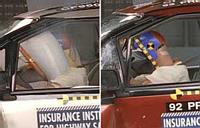IIHS Air Bags - The Story
Virtually all new cars have airbags, and they're saving lives. They're reducing driver deaths by about 14 percent, and passenger bags reduce deaths by about 11 percent.
People who use safety belts may think they don't need airbags. But they do. Airbags and lap/shoulder belts work together as a system, and one without the other isn't as effective. Deaths are 12 percent lower among drivers with belts and 9 percent lower among belted passengers.
But there also are problems with airbags. Inflating bags have caused some serious injuries and deaths.
 |
Position is what counts Serious inflation injuries occur primarily because of people's positions when airbags first begin inflating. Anyone, regardless of size or age, who's on top of, or very close to, an airbag is at risk. Most airbag deaths have involved people who weren't using belts, were using them incorrectly, or were positioned improperly.
People without belts or using them incorrectly, especially passengers, are at risk because they're likely to move forward during hard braking or other violent maneuvers before crashes. Then they're likely to be very close to, or on top of, airbags before inflation begins. Improperly positioned people at risk include drivers who sit very close to the steering wheel -- 10 inches or closer -- and infants in rear-facing restraints in front seats.
Understanding that airbag injury risk is related to position leads to a few simple steps that can eliminate the risks without sacrificing airbag benefits.
If there's no choice but to put a baby in the front seat, then an on/off switch for the passenger airbag is essential. But before you do this, remember the back seat is safer. Even without airbags, kids riding in back are much less likely to be killed. Now riding in back is even more important because it keeps children away from inflating airbags.
When babies outgrow their rear-facing restraints, they should graduate to forward-facing ones or booster seats attached to a vehicle's back seat with an adult safety belt. As kids later graduate to adult belts, proper restraint use still is essential. Don't put the shoulder portion of a belt behind a child or under the arm. And don't let a youngster do this, either, because it compromises protection. A lap belt should be positioned so it's low and snug across a child's hips, not up over the abdomen.
Older kids should continue riding in a back seat. Only if there are too many children to put them all in back should a child be allowed to ride up front. Then make sure the seat is all the way back and the child is securely buckled and sitting back in the seat. Leaning forward to, for example, fiddle with radio dials can put a child at risk. If you worry about keeping a child sitting back, you may wish to consider getting an on/off switch for the passenger airbag.
Shorter drivers benefit from airbags: The benefits for short drivers are illustrated by two flat-barrier crash tests at 35 mph, each with a 5-foot female dummy using a safety belt. The driver seats were moved nearly all the way forward, and each dummy's knees almost touched the instrument panel. One car had an airbag, which effectively protected the small dummy. In the other car -- the same model except there was no airbag -- the dummy's face hit the steering wheel rim hard enough to bend it severely.
Adults: buckle up and sit back It isn't your size, gender, or age that determines risk. It's position in relation to an airbag. Most adults can virtually eliminate the risk by buckling up. Neither short women nor elderly drivers are especially vulnerable if they use safety belts and sit at least 10 inches from the steering wheel.
 |
Kids in back Don't put a rear-facing restraint in the front seat. Starting with the first trip home from the hospital, put an infant in the center back seat. Make sure the rear-facing restraint is tightly secured to the vehicle with an adult safety belt and the baby is buckled snugly in.
Belted drivers potentially at risk of serious airbag injury are those sitting very close to the steering wheel. But the same drivers would be at risk without airbags because they're likely to hit the steering wheel hard -- usually with the face -- in a serious crash. They can reduce the airbag risk without sacrificing the benefits by sitting back and away from the wheel.
Most drivers, even short ones, can get at least 10 inches from the steering wheel and still reach the pedals. The problem often is that drivers sitting closer are leaning forward instead of sitting back in their seats. They need only sit back. The few who cannot get 10 inches from the steering wheel and still comfortably reach the pedals may wish to consider pedal extenders (call 813/932-8566 for information about these).
On/off switches for airbags The federal government has set criteria for the very few cases when airbag on/off switches may be needed to avoid injury risk. But getting a driver airbag switch makes sense only when someone -- for example, a very short person -- has tried various positions and cannot comfortably drive while sitting back and away from the steering wheel. A woman late in pregnancy who cannot get her abdomen away from the steering wheel also may wish to get permission for a switch based on medical need. But remember that in a serious crash without an airbag, sitting so close to the wheel means a high risk of hitting it.
Most 1998 and later cars will have redesigned airbags with less powerful inflators that reduce injury risk. In these cars, there's probably no need to get an on/off switch for a driver airbag even if you cannot get 10 inches from the wheel. Still, it's best to sit back and away from an airbag.
 |
On the passenger side, there's no significant airbag injury risk for belted adults sitting back in the seat. The risk for infants and children can be eliminated by ensuring they ride in a back seat, properly restrained. The back is safer anyway.
So should you even consider getting an on/off switch for a passenger airbag? Rarely -- for example, when an infant with medical problems requires constant observation and the driver is the only other person in the vehicle. Then there might be no choice except to put the baby up front, and the airbag would present a risk. Of course, paying constant attention to a baby distracts from driving and involves its own risks.
Another group is parents who transport too many infants or small children to put them all in back and are concerned about keeping the child in front sitting back and away from the airbag. In this case, you may wish to get an on/off switch. If you do get one, remember to use it correctly. Remember to turn off the airbag when an infant or child must ride in front.
The decision about airbag on/off switches should be made with the facts in mind. Then it becomes clear that getting a switch rarely is necessary. Just take the simple precautions spelled out here to eliminate the potential risk.

|
On the passenger side, there's no significant airbag injury risk for belted adults sitting back in the seat. The risk for infants and children can be eliminated by ensuring they ride in a back seat, properly restrained. The back is safer anyway.
Airbags provide protection even to people who use their safety belts: Two frontal offset crash tests at 40 mph involve passenger vans -- one in which the dummy was restrained by a safety belt plus an airbag, the other in which the dummy had only a belt. Forces measured on the head of the dummy with the airbag indicate little or no risk of serious head injury. But the dummy with only the belt hit the steering wheel hub with sufficient force for fatal head injury to be almost certain.
Future is advanced airbags The problem of serious inflation injuries isn't going to be with us forever. Most 1998 models have redesigned airbags, and future airbag technologies will reduce the risk even among people who have moved forward before airbags inflate. Sensors will detect rear-facing restraints and automatically switch off passenger bags. Inflation rates will be tailored to crash severity. More advanced airbags could recognize people's positions just before inflating and reduce the force if someone is in position to be harmed.


